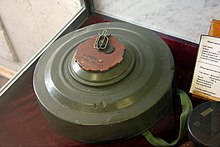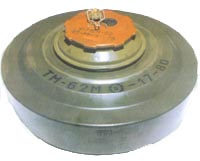This is the current revision of this page, as edited by DragonEggLol (talk | contribs) at 03:05, 13 January 2025 (Added another source on TM-62 drone payloads). The present address (URL) is a permanent link to this version.
Revision as of 03:05, 13 January 2025 by DragonEggLol (talk | contribs) (Added another source on TM-62 drone payloads)(diff) ← Previous revision | Latest revision (diff) | Newer revision → (diff) Soviet anti-tank mine| This article includes a list of general references, but it lacks sufficient corresponding inline citations. Please help to improve this article by introducing more precise citations. (December 2014) (Learn how and when to remove this message) |
| TM-62 mine | |
|---|---|
 | |
| Type | Anti-tank blast mine |
| Place of origin | Soviet Union |
| Service history | |
| Used by | See Users |
| Wars | Rhodesian Bush War South African Border War Angolan Civil War Mozambican Civil War Second Sudanese Civil War First Nagorno-Karabakh War Russo-Ukrainian War Second Nagorno-Karabakh War |
| Production history | |
| Variants | See Variants |

The TM-62 is a series of Soviet anti-tank blast mines produced in various variants. It served as the primary anti-tank landmine for the Soviet military. It has a central fuze and typically a 7.5 kilograms (17 lb) explosive charge, but the variants differ greatly in detail. The mine can be laid manually or automatically from a mine laying machine including the PMR-1, PMR-2 wheeled towed mine layers, the GMZ-3 tracked mine laying vehicle and the VMR-2 helicopter mine laying system. The TM-62 can be fitted with the same fuzes as the TM-72, which include MVN-72 and MVN-80 fuzes, which are vibration and magnetism sensitive. The mine was used in the 2022 Russian invasion of Ukraine.
Russo-Ukrainian War
Both Ukrainian and Russian soldiers have been observed to use modified TM-62s as satchel charges. In addition, Ukrainian forces have deployed drones equipped with modified TM-62 payloads for precision strikes. Strikes by a Russian UAV drone, the "Molniya-2," using a TM-62 mine as a warhead, have also been documented starting January 2025.
Variants

- TM-62M, with a circular metal case. It is the most widely employed variant.
- TM-62B, with a paper or cardboard case – basically a block of cast explosive with a fuze set into the center.
- TM-62D, with a wooden case.
- TM-62P, TM-62P2 and TM-62P3, with plastic cases. The TM-62P and TM-62P2 mine cases have ribbed sides, whereas the TM-62P3 has a smooth casing.
- TM-62T, with a fabric and epoxy casing and a central fuze.
Fuzes
- MVZ-62
- MVCh-62, the standard fuze with a clockwork arming delay of 30 to 120 seconds.
- MVN-62
- MVN-72, with a combination of electronics and clockwork, after an initial arming delay the magnetic influence fuze is enabled, powered by a 1.5 V battery.
- MVN-80, an improved version of the MVN-72.
- VM-62Z
- MVP-62, with a pneumatic bellows arming delay of 20 to 300 seconds. The delay mechanism uses a minimum of metal making it difficult to detect when used with one of the minimum metal cases.
- MVP-62M
- ZN-97, a magnetic influence fuze made in Poland.
Magnetic influence fuzes provide full-width attack, i.e. any part of the target vehicle passing over the mine will trigger detonation, not just the track or wheels. However, since magnetic fuzes are electronic, their operational life relies on battery power. Ultimately the battery will run down, after which the mine no longer functions. In contrast, a purely mechanical fuze (usually triggered via a Belleville spring) gives a much longer operational life (e.g., mines planted 50 years previously will still detonate if a target vehicle drives over them).
Specifications (TM-62M with MVZ-62 fuze)
- Weight: 9.5 kilograms (21 lb)
- Explosive content: 7.5 kilograms (17 lb) of TNT (although sometimes combinations of RDX/TNT/Aluminium or Amatol mixes are used)
- Diameter: 320 millimetres (13 in)
- Height: 128 millimetres (5.0 in)
- Operating pressure: 150 to 550 kilograms (330 to 1,210 lb)
Users

 Afghanistan
Afghanistan Armenia
Armenia Angola
Angola Belarus
Belarus Bulgaria
Bulgaria Georgia
Georgia Moldova
Moldova Mozambique
Mozambique Poland, as the MPP-B Wierzba mine
Poland, as the MPP-B Wierzba mine Romania, as the MAT-62B mine
Romania, as the MAT-62B mine Russia
Russia Syria
Syria Ukraine
Ukraine
Former users
See also
References
- ^ "STILL KILLING: Landmines in Southern Africa". Human Rights Watch. 1997. Archived from the original on 2024-09-15. Retrieved 2025-01-10.
- ^ Kuzio, Taras (2021-04-16). "Mines, Karabakh and Armenia's crisis". New Eastern Europe. Archived from the original on 2025-01-11. Retrieved 2025-01-10.
- ^ Мельникова, Виктория (2024-08-02). "ВС РФ применили переделанные мины ТМ-62 для подрыва "опорников" противника". AiF (in Russian). Archived from the original on 2025-01-11. Retrieved 2024-08-03.
- ^ "CISR Munitions Reference Guide". James Madison University. Archived from the original on 2025-01-11. Retrieved 2025-01-11.
- TAB (2024-07-14). "Anti-Tank Mines Used As Satchel Charges". The Armourers Bench. Archived from the original on 2025-01-11. Retrieved 2024-12-11.
- TAB (2023-10-01). "Heavy Drone Bombers Dropping Anti-Tank Mines". The Armourers Bench. Archived from the original on 2025-01-11. Retrieved 2025-01-11.
- "Ukraine's ingenious use of drones turns battlefield tides". MSN. Retrieved 2025-01-13.
- "Landmine Monitor: ASIA-PACIFIC NON-SIGNATORIES, AFGHANISTAN". Human Rights Watch. 1997. Archived from the original on 2021-12-15. Retrieved 2025-01-10.
- "Landmine and Cluster Munition Monitor: Moldova". Landmine and Cluster Munition Monitor. Retrieved 2025-01-12.
- Jane's Mines and Mine Clearance 2005–2006